Summary: Depth-first Search(DFS)
There are generally two methods to write DFS algorithm, one is using recursion, another one is using stack. (reference from Wiki Pedia)
Pseudocode for both methods:
A recursive implementation of DFS:
procedure DFS(G,v):
label v as discovered
for all edges from v to w in G.adjacentEdges(v) do
if vertex w is not labeled as discovered then
recursively call DFS(G,w)
A non-recursive implementation of DFS(using stack):
procedure DFS-iterative(G,v):
let S be a stack
S.push(v)
while S is not empty
v ← S.pop()
if v is not labeled as discovered:
label v as discovered
for all edges from v to w in G.adjacentEdges(v) do
S.push(w)
The non-recursive implementation is similar to breadth-first search but differs from it in two ways: it uses a stack instead of a queue, and it delays checking whether a vertex has been discovered until the vertex is popped from the stack rather than making this check before pushing the vertex.
Here's another good explenation: http://www.algolist.net/Algorithms/Graph/Undirected/Depth-first_search
Depth-first search, or DFS, is a way to traverse the graph. Initially it allows visiting vertices of the graph only, but there are hundreds of algorithms for graphs, which are based on DFS. Therefore, understanding the principles of depth-first search is quite important to move ahead into the graph theory. The principle of the algorithm is quite simple: to go forward (in depth) while there is such possibility, otherwise to backtrack.
Algorithm
In DFS, each vertex has three possible colors representing its state:
 white: vertex is unvisited;
white: vertex is unvisited;
 gray: vertex is in progress;
gray: vertex is in progress;
 black: DFS has finished processing the vertex.
black: DFS has finished processing the vertex.
NB. For most algorithms boolean classification unvisited / visited is quite enough, but we show general case here.
Initially all vertices are white (unvisited). DFS starts in arbitrary vertex and runs as follows:
- Mark vertex u as gray (visited).
- For each edge (u, v), where u is white, run depth-first search for u recursively.
- Mark vertex u as black and backtrack to the parent.
Example. Traverse a graph shown below, using DFS. Start from a vertex with number 1.
 |
Source graph. |
 |
Mark a vertex 1 as gray. |
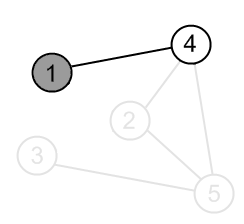 |
There is an edge (1, 4) and a vertex 4 is unvisited. Go there. |
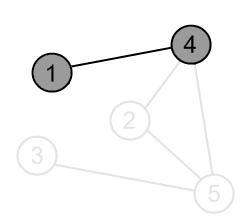 |
Mark the vertex 4 as gray. |
 |
There is an edge (4, 2) and vertex a 2 is unvisited. Go there. |
 |
Mark the vertex 2 as gray. |
 |
There is an edge (2, 5) and a vertex 5 is unvisited. Go there. |
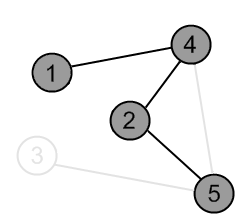 |
Mark the vertex 5 as gray. |
 |
There is an edge (5, 3) and a vertex 3 is unvisited. Go there. |
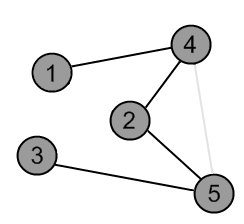 |
Mark the vertex 3 as gray. |
 |
There are no ways to go from the vertex 3. Mark it as black and backtrack to the vertex 5. |
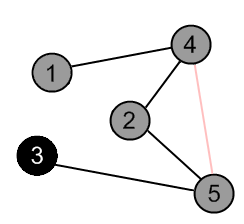 |
There is an edge (5, 4), but the vertex 4 is gray. |
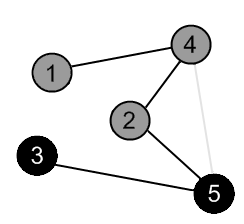 |
There are no ways to go from the vertex 5. Mark it as black and backtrack to the vertex 2. |
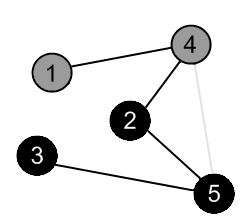 |
There are no more edges, adjacent to vertex 2. Mark it as black and backtrack to the vertex 4. |
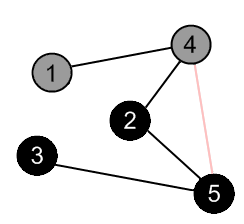 |
There is an edge (4, 5), but the vertex 5 is black. |
 |
There are no more edges, adjacent to the vertex 4. Mark it as black and backtrack to the vertex 1. |
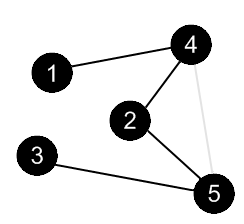 |
There are no more edges, adjacent to the vertex 1. Mark it as black. DFS is over. |
Complexity analysisIf a graph is disconnected, DFS won't visit all of its vertices. For details, see finding connected components algorithm.As you can see from the example, DFS doesn't go through all edges. The vertices and edges, which depth-first search has visited is a tree. This tree contains all vertices of the graph (if it is connected) and is called graph spanning tree. This tree exactly corresponds to the recursive calls of DFS.
Assume that graph is connected. Depth-first search visits every vertex in the graph and checks every edge its edge. Therefore, DFS complexity is O(V + E). As it was mentioned before, if an adjacency matrix is used for a graph representation, then all edges, adjacent to a vertex can't be found efficiently, that results in O(V2)complexity. You can find strong proof of the DFS complexity issues in [1].
Java Implementation
public class Graph {
…
enum VertexState {
White, Gray, Black
}
public void DFS()
{
VertexState state[] = new VertexState[vertexCount];
for (int i = 0; i < vertexCount; i++)
state[i] = VertexState.White;
runDFS(0, state);
}
public void runDFS(int u, VertexState[] state)
{
state[u] = VertexState.Gray;
for (int v = 0; v < vertexCount; v++)
if (isEdge(u, v) && state[v] == VertexState.White)
runDFS(v, state);
state[u] = VertexState.Black;
}
}
Summary: Depth-first Search(DFS)的更多相关文章
- [Algorithm] Write a Depth First Search Algorithm for Graphs in JavaScript
Depth first search is a graph search algorithm that starts at one node and uses recursion to travel ...
- [算法&数据结构]深度优先搜索(Depth First Search)
深度优先 搜索(DFS, Depth First Search) 从一个顶点v出发,首先将v标记为已遍历的顶点,然后选择一个邻接于v的尚未遍历的顶点u,如果u不存在,本次搜素终止.如果u存在,那么从u ...
- 幸运的袋子(深度优先遍历(Depth First Search,DFS))
题目描述 一个袋子里面有n个球,每个球上面都有一个号码(拥有相同号码的球是无区别的).如果一个袋子是幸运的当且仅当所有球的号码的和大于所有球的号码的积. 例如:如果袋子里面的球的号码是{1, 1, 2 ...
- Non recursive Depth first search
深度优先非递归实现算法: 1 递归算法: //初始化相关数据结构 DFS(G) ------------------------------------------------------------ ...
- Recursive Depth first search graph(adj matrix)
1 深度优先遍历邻接矩阵 1 邻接矩阵初始化 2 访问数组初始化 3 深度优先遍历邻接矩阵图 算法如下: bool MGraph[128][128]; bool visit[128]; int vex ...
- 深度优先搜索(Depth First Search)
Date:2019-07-01 15:31:11 通俗点理解就是不撞南墙不回头的那种,用栈来实现 算法实现 /* 题目描述: 有n件物品,每件物品的重量为w[i],价值为c[i].现在需要选出若干件物 ...
- 深度优先搜索 DFS(Depath First Search, DFS)
深度优先搜索是一种枚举所有完整路径以遍历所有情况的搜索方法.(不撞南墙不回头) DFS一般用递归来实现,其伪代码思路过程一般如下: void DFS(必要的参数){ if (符和遍历到一条完整路 ...
- [MIT6.006] 14. Depth-First Search (DFS), Topological Sort 深度优先搜索,拓扑排序
一.深度优先搜索 它的定义是:递归探索图,必要时要回溯,同时避免重复. 关于深度优先搜索的伪代码如下: 左边DFS-Visit(V, Adj.s)是只实现visit所有连接某个特定点(例如s)的其他点 ...
- 数据结构学习笔记05图 (邻接矩阵 邻接表-->BFS DFS、最短路径)
数据结构之图 图(Graph) 包含 一组顶点:通常用V (Vertex) 表示顶点集合 一组边:通常用E (Edge) 表示边的集合 边是顶点对:(v, w) ∈E ,其中v, w ∈ V 有向边& ...
随机推荐
- YAML语法介绍
官网YAML: http://yaml.org/ http://yaml.org/xml 参考链接: http://www.ruanyifeng.com/blog/2016/07/yaml.html? ...
- Nginx之让用户通过用户名密码认证访问web站点
有时我们会有这么一种需求,就是你的网站并不想提供一个公共的访问或者某些页面不希望公开,我们希望的是某些特定的客户端可以访问. 那么我们可以在访问时要求进行身份认证,就如给你自己的家门加一把锁,以拒绝那 ...
- Artech的MVC4框架学习——第八章View的呈现
总结:定义在controller中的action方法一般会返回actionResult的对象对请求给予 响应.viewResult是最常见也是最重要的ActionView的一种(p411).view模 ...
- Spark ML包,数据挖掘示例数据Affairs
1.数据字段解释 affairs:一年来婚外情的频率 gender:性别 age:年龄 yearsmarried:婚龄 children:是否有小孩 religiousness:宗 ...
- C#调用C++ DLL的方式
动态链接库(DLL)是一个包含可由多个程序同时使用的代码和数据的库,DLL不是可执行文件.可以说在windows操作系统中随处可见,打开主分区盘下的system32.在一些项目中,如果有大量运算或者涉 ...
- binlog介绍
1.什么是binlog binlog是一个二进制格式的文件,用于记录用户对数据库更新的SQL语句信息,例如更改数据库表和更改内容的SQL语句都会记录到binlog里,但是对库表等内容的查询不会记录. ...
- Docker命令详解(build篇)
命令格式:docker build [OPTIONS] <PATH | URL | -> Usage: Build an image from a Dockerfile. 中文意思即:使用 ...
- ubuntu 添加用户到已存在的组
sudo adduser 用户名 组名 sudo minicom –s 配置 minicom访问ttyUSB0没权限,发现属于dialout 组 james@james-OptiPlex-380: ...
- bit 32/64
[asm]64位编译32位汇编需要注意的 汇编语言在32位和64位下有区别 32位的汇编在代码前增加.code32 as可以通过--32指定生成32位汇编 在64位系统下ld链接生成3 ...
- 最大生成树——LCA
今天说是要练习LCA结果找了道题看着题解打完了,如此惭愧,Lca还得好好理解啊,感觉在最大生成树上做有点异样,可能还是不是很理解吧,在noip前一定要再把这道题再a一遍,好题啊. 这是2013noip ...
